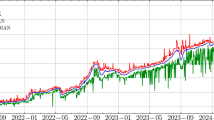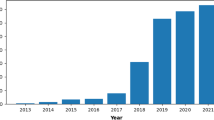Abstract
In an asset market without bubbles, meaning the strong efficient markets hypothesis is satisfied, the price and dividend should be cointegrated. However, standard unit root tests have low power against a class of Periodically Collapsing Rational Bubbles introduced by (Evans, Am Econ Rev 81:922–930, 1991), which are an intuitive model of speculative behavior. The cryptocurrency markets for bitcoin, ethereum, and ripple do not have dividends, so the tests are conducted using five different proxies for fundamentals. In most cases the price and fundamental data are integrated of order one, according to a minimum LM test for unit roots that allows for breaks. Using a robust test for cointegration that controls for the skewness and excess kurtosis that could arise with such bubbles, one cannot reject the presence of Period Collapsing Rational Bubbles in any of the cryptocurrency markets. The distribution of such tests is non-standard, so significance levels are determined with Monte Carlo experiments.

Similar content being viewed by others
References
Bhargava A (n.d.) On the Theory of Testing for Unit Roots in Observed Time Series. Rev Econ Financ 53:369–384
Cheah E-T, Fry J (2015) Speculative bubbles in Bitcoin markets? An empirical investigation into the fundamental value of Bitcoin. Econ Lett 130:32–36
Cochrane J (2018) The bitcoin market isn’t irrational. Chicago Booth Review. http://review.chicagobooth.edu/Önance/2018/article/bitcoin-market-isn-t-irrational. Accessed March 16, 2021
Diba BT, Grossman HI (1988) Explosive rational bubbles in stock prices? Am Econ Rev 78(3):520–530
Evans GW (1991) Pitfalls in testing for explosive bubbles in asset prices. Am Econ Rev 81(4):922–930
Hayes AS (2019) Bitcoin price and its marginal cost of production: support for a fundamental value. Appl Econ Lett 26(7):554–560
Hommes C, Wagener F (2009) Complex Evolutionary Systems in Behavioral Finance. Chapter 4. In T Hens, KR Schenk-Hoppé (eds) Handbook of financial markets: dynamics and evolution. Elsevier
Lee, Strazicich (2003) Minimum lagrange multiplier unit root test with two structural breaks. The review of economics and statistics 85(4):1082–1089
Lee, Strazicich (2013) Minimum LM unit root test with one structural break. Economics bulletin 33(4):2483–2492
Makarov I, Schoar A (2020) Trading and arbitrage in cryptocurrency markets. J Financ Econ 135(2):293–319
Shiller RJ (2017) What is bitcoin really worth? don’t even ask. New York Times. https://www.nytimes.com/2017/12/15/business/bitcoin-investing.html. Accessed 1 Dec 2019
Taylor MP, Peel DA (1998) Periodically collapsing stock price bubbles: a robust test. Econ Lett 61(2):221–228
Waters GA (2008) Unit root testing for bubbles: A Resurrection? Econ Lett 101(3):279–281
Waters George A (2019) Bubbles and rationality in bitcoin. Econ Notes: Rev Bank Financ Monet Econ 48(2):e12133
Zaharia M, Kim D (2018) Bitcoin start-ups in Asia take aim at remittances market.” Reuters online. https://www.reuters.com/article/us-crypto-currencies-remittances/bitcoin-start-ups-in-asia-take-aim-at-remittances-market-idUSKCN1GP117. Accessed March 16, 2021
Author information
Authors and Affiliations
Corresponding author
Additional information
Publisher's note
Springer Nature remains neutral with regard to jurisdictional claims in published maps and institutional affiliations.
Appendix
Appendix
Distribution of the 10,000 simulated CR statistics the Monte Carlo experiment using eq. (4) for values determined by the log(BTCP)
Rights and permissions
About this article
Cite this article
Waters, G.A., Bui, T. An empirical test for bubbles in cryptocurrency markets. J Econ Finan 46, 207–219 (2022). https://doi.org/10.1007/s12197-021-09561-9
Accepted:
Published:
Issue Date:
DOI: https://doi.org/10.1007/s12197-021-09561-9





